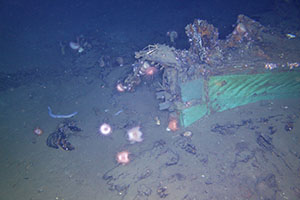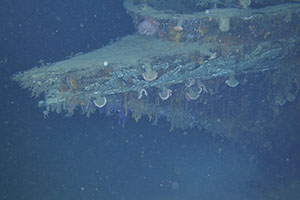Two sampling cruises were completed in 2014. A third cruise in April 2015 conducted additional water and sediment sampling at the study sites for comparison. Microbiome experiments and data analysis is currently underway in the laboratory. Visit the project website at: http://hamdanlab.com/gom-schema/.
 BOEM scientists aboard the R/V Pelican investigated eight shipwrecks in the Gulf of Mexico in water depths ranging from approximately 450 feet to more than 7,500 feet in a National Oceanographic Partnership Program-sponsored study. The project, Gulf of Mexico Shipwreck Corrosion, Hydrocarbon Exposure, Microbiology, and Archaeology (GOM-SCHEMA), is funded by BOEM through interagency agreements with the U.S. Naval Research Laboratory and Bureau of Safety and Environmental Enforcement, a cooperative agreement with George Mason University, a contract with C&C Technologies, and support from the University-National Oceanographic Laboratories System (UNOLS). Other collaborators include the Louisiana Universities Marine Consortium (LUMCON), the Joye Research Group at the University of Georgia, Droycon Bioconcepts, Inc., the PAST Foundation, Montana State University, and Deep Sea Systems International (DSSI).
BOEM scientists aboard the R/V Pelican investigated eight shipwrecks in the Gulf of Mexico in water depths ranging from approximately 450 feet to more than 7,500 feet in a National Oceanographic Partnership Program-sponsored study. The project, Gulf of Mexico Shipwreck Corrosion, Hydrocarbon Exposure, Microbiology, and Archaeology (GOM-SCHEMA), is funded by BOEM through interagency agreements with the U.S. Naval Research Laboratory and Bureau of Safety and Environmental Enforcement, a cooperative agreement with George Mason University, a contract with C&C Technologies, and support from the University-National Oceanographic Laboratories System (UNOLS). Other collaborators include the Louisiana Universities Marine Consortium (LUMCON), the Joye Research Group at the University of Georgia, Droycon Bioconcepts, Inc., the PAST Foundation, Montana State University, and Deep Sea Systems International (DSSI).
 During two field cruises in 2014 (March 16–21 and July 16–24), this multidisciplinary team of scientists representing the fields of marine archaeology, microbial ecology, molecular biology, geochemistry, geology, and corrosion studies collected samples using the ROV GlobalExplorer to determine if several of the shipwrecks and their resident biological communities were exposed to oil and/or dispersant from the Deepwater Horizon oil spill in 2010. The team also collected similar samples from shipwrecks located outside of the oil spill area for comparison. The shipwrecks – three World War II-era steel-hulled vessels and five pre-20th century wooden hulled sailing ships – have been previously investigated by BOEM. See Project Overview.
During two field cruises in 2014 (March 16–21 and July 16–24), this multidisciplinary team of scientists representing the fields of marine archaeology, microbial ecology, molecular biology, geochemistry, geology, and corrosion studies collected samples using the ROV GlobalExplorer to determine if several of the shipwrecks and their resident biological communities were exposed to oil and/or dispersant from the Deepwater Horizon oil spill in 2010. The team also collected similar samples from shipwrecks located outside of the oil spill area for comparison. The shipwrecks – three World War II-era steel-hulled vessels and five pre-20th century wooden hulled sailing ships – have been previously investigated by BOEM. See Project Overview.
Additionally, scientists deployed experiments at these shipwrecks to study biofilm formation and corrosion processes. During the July 2014 cruise, the team recovered the short-term experiments deployed in March. Prior to the July cruise, the team collected 3-D laser and 3-D acoustic scans of the shipwrecks (with sub-centimeter accuracy) to document their current condition and provide baseline information for long-term monitoring purposes.
In April 2015, another cruise was conducted on the R/V Pelican to collect additional water samples and sediment cores from the shipwreck sites for comparison with those collected in 2014. Participants on the 2015 cruise included scientists from George Mason University, Woods Hole Oceanographic Institution, U.S. Naval Research Lab, University of Texas Marine Science Institute, and American University.
Once the lab experiments and analyses are complete the study will be published. For more information, visit the project website at: http://hamdanlab.com/gom-schema/, view it on Facebook at GOM-SCHEMA, and follow the Twitter feed @hamdanlab.
Gulf of Mexico Shipwreck Study Launches
Second Expedition on the Research Vessel Pelican
